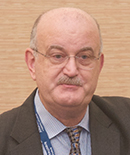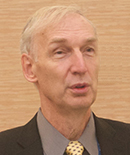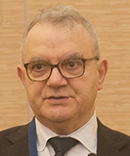Postoperative complications are a problem area in anesthesia, but studies define a road to help reduce them. During Tuesday’s “Neuromuscular Physiology, Pharmacology and Monitoring: Debunking the Myths,” four anesthesiologists examined the need for better guidelines, the use of scientific methods to assess anesthesia recovery, objective monitoring and debunking myths about operating conditions to improve treatment.
Lack of guidelines

Sorin J. Brull, M.D.
An Anesthesia Patient Safety Foundation panel discussion last Saturday reported that in a recent survey, 75 percent of anesthesia professionals think better practice guidelines for postoperative anesthesia care are needed. However, comprehensive guidelines are lacking around the world, including the United States.
Sorin J. Brull, M.D., reviewed the guidelines of 11 anesthesia societies and found most of them lacking. ASA’s Task Force on Postanesthetic Care issued a report that “assessment of neuromuscular function primarily includes physical examination and, on occasion, may include neuromuscular blockade monitoring.” The most comprehensive guideline is from the Czech Society of Anaesthesiology and Intensive Care Medicine, he said.
“Official guidelines from professional societies regarding intraoperative monitoring and management of neuromuscular block are generally nonexistent,” said Dr. Brull, Professor of Anesthesiology and Perioperative Medicine at the Mayo Clinic College of Medicine, Jacksonville, Florida.
Studies have determined that critical respiratory events occur in 0.8 percent of patients who have residual block. Even with conservative estimates, that means 500,000 patients suffer bad events postoperatively because of residual block, he said.
Is current practice safe?

Richard C. Prielipp, M.D., M.B.A.
Anesthesiologists have employed a variety of subjective clinical assessments of recovery from anesthesia for many years, but those tests are not always a good gauge of recovery. Richard C. Prielipp, M.D., M.B.A., Professor in the University of Minnesota Department of Anesthesiology, explained some of the problems with those tests.
The most common test of whether anesthesia is adequately reversed is the five-second head lift, he said.
“Can we rely on that as our physical test for recovery? There is pretty convincing evidence this test does not have the sensitivity or specificity that we may have assumed it has,” he said, citing studies of the test’s effectiveness.
A better option can be a portable nerve stimulator (PNS) to depolarize a peripheral nerve proximal to a defined motor unit. The best test for using a PNS is on the ulnar nerve to the adductor pollicis brevis muscle of the thumb because it isolates a single motor response, Dr. Prielipp said.
Several patterns of nerve stimulation are available in testing, and the most popular is the train-of-four (TOF). However, studies show it is not reliable.
“It is barely better than the flip of a coin to diagnose accurately using TOF,” Dr. Prielipp said, adding that a better option is double-burst stimulation.
Postoperative neuromuscular weakness is a continuing clinical problem. Quantitative monitoring is a better option because it is objective.
“The depth of neuromuscular block cannot be guessed, inferred or assessed by subjective means no matter how talented you may be or how much clinical experience you have,” Dr. Prielipp said, as he read from an Anesthesiology editorial he wrote with Dr. Brull. “You really need some assistance to make this determination in the most accurate fashion possible.”
Does neuromuscular block improve surgical conditions?

Mohamed Naguib, M.D., M.B., B.Ch., M.Sc.
The depth of anesthesia needed to create optimal conditions in the operating room was explored by Mohamed Naguib, M.D., M.B., B.Ch., M.Sc., Professor of Anesthesiology at Cleveland Clinic.
Dr. Naguib reviewed multiple studies to examine the effect of standard versus low insufflation pressures on patient outcomes and the effect of moderate versus deep neuromuscular blockade on surgical conditions and patient outcomes.
Low inflation pressures (8 mmHg), even when associated with deep neuromuscular blocks, can result in a high incidence of inadequate surgical conditions, Dr. Naguib said. He also said that maintaining an inflation pressure of more than 15 mmHG with a deep neuromuscular block is “pointless.”
Deeper levels of neuromuscular blocks might occasionally be required during laparoscopic surgery, but deep anesthesia does not replace surgical skill in optimizing surgery.
“Optimal surgical conditions are the result of synergistic effects of carefully titrated anesthetics, analgesics and NMBDs,” Dr. Naguib said. “Deep block does not replace surgical skill nor does it change patient anatomy.”
Postoperative pulmonary complications

Glenn S. Murphy, M.D.
Postoperative residual neuromuscular block is the greatest problem of pulmonary complications following surgery, said Glenn S. Murphy, M.D., the Jeffrey S. Vender Chair of Anesthesiology Research and Education at NorthShore University HealthSystem.
Dr. Murphy reviewed several studies, including one that showed that 2-5 percent of patients develop pulmonary complications following surgery.
“What they found was a clear association between the more muscle relaxant we gave and the risk of these postoperative pulmonary complications. We don’t know that it is residual block, but we sense that it is,” Dr. Murphy said.
Other studies also showed that the risk of pneumonia increases with the increased use of muscle relaxers. They also indicated that if residual block is not reversed, the risk of pneumonia increases significantly, he said.
Dr. Murphy summarized studies to link complications following surgery to the lack of recognition that neuromuscular block had not been sufficiently reversed. He called for the use of quantitative monitors in postoperative intensive care units to improve assessment of anesthesia recovery.
“A high percentage of residual block exists in all of our practices,” he said. “I think we have to be better about our dosing, monitoring and reversal practices.”
Return to Archive Index